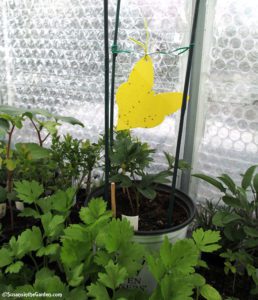Fungus Gnats
Latin name: Bradysia spp., Orfelia spp., Lycoriella spp.
Size: 1/8″
Color: Dark brown/black
Life cycle: The adult flies and larvae are found in, and feed upon, potting soil and garden soil. When the adults emerge from the soil, they mate and the female lays eggs in the soil. The larvae go through 4 instars (stages), then pupate and emerge as an adult. The entire life cycle occurs over the course of 17 days! Many generations can be produced in a year’s time, especially when temperatures are warmer.
Symptoms of their activity: You will see lots of small gnats on and around seedling flats or houseplants. They are annoying to us humans but there’s more to it than that. The larvae can feed on the roots of plants, decreasing the plants’ vigor, and they can also spread root diseases.
Typically seen on: The soil of houseplants or seedling flats, but also out in the garden.
Controls: Use sticky traps to control adults. There is a strain of Bt (Bacillus thuringiensis subspecies israelensis) that is toxic to fly larvae, including gnats, mosquitoes and black flies. Look for granular products such as Mosquito Bits in garden centers; just sprinkle a layer of them over the surface of the pot (follow label directions).
Cultural controls: Make sure soil isn’t staying too moist. You can also solarize potting soil by placing it in a clear or black plastic bag (just fill with about 8″ of soil at a time) and setting the bag in a sunny area for 4 to 6 weeks.
Natural predators: Nematodes
Additional information: University of California Fungus Gnats Management and Colorado State University Fungus Gnats as Houseplant and Indoor Pests.
Back to Organic Pest Control

